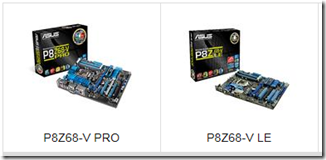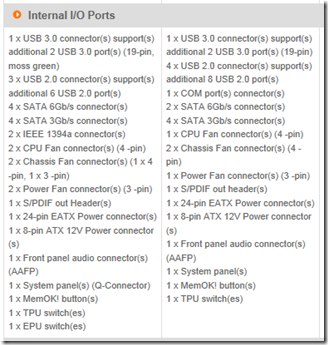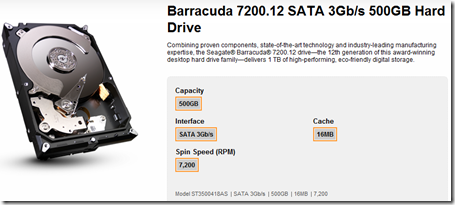Building the Ultimate Developer Computer for $1000 - The Parts List
I am due for a new computer. Following on the foot steps of Scott Hanselman (Ultimate Developer PC 2.0) and Jeff Atwood (Building a PC, Part VII: Rebooting) I decided to build my own computer. I have built my own machine before but in the past it has been with mixed success. Usually I have run into issues with getting a complete set of compatible parts, or fitting all of the components into the case.
Prior to giving building my own computer another try, I did shop around for pre-built computers (Dell, CyberPower). The prices of some pre-built computers certainly do make just buying one from a company like Dell or CyberPower very attractive (and also you are practically guaranteed a fully compatible set of hardware), but you do not always get the high-performance machine that I wanted (at least not without paying a premium). So not only is building my own machine about putting together a high-performance computer, it also has to be very cost effective to be a better deal than prebuilt off-the-shelf computers.
I set $1000 as the goal because above $1000 I felt I could get a pretty decent machine from one of the pre-built shops (albeit maybe with some components that I did not necessarily want). The $1000 price goal also made an assumption that I might sacrifice on some parts knowing that I could upgrade them in the future if this goes well.
So here goes... below is the list of parts that I selected to build my $1000 Ultimate Developer Machine.
I borrowed heavily from Jeff Atwood’s latest post on rebuilding his machine. He posted it in July 2011 so the parts list was still very up to date. The only issue was that his selected parts cost just under $2000 and, as mentioned above, I wanted to have it at or under $1000.
Pulling from his list of parts and skimping and saving where I could I came up with the following parts that I finally went with. I will talk about each of these later in this post.
- ASUS LGA 1155 - Z68 - SATA 6Gb/s and USB 3.0 - ATX Intel Z68 ATX DDR3 2200 Motherboard (P8Z68-V LE) – $129.99
- Corsair CC600TWM-WHT Special Edition Graphite Series 600T Mid Tower Gaming Computer Case - $159.09
- Corsair Enthusiast TX V2 Series 550-Watt 80 Plus Bronze Certified High Performance Modular Power Supply – $87.59
- Intel Core i5-2500K Processor – $214.99
- Crucial 64 GB m4 2.5-Inch Solid State Drive SATA 6Gb/s – $109.99
- Corsair Vengeance Blue 16 GB DDR3 SDRAM Dual Channel Memory Kit - $99.99
- Sapphire HD 6850 PCIE Video Card - $149.99
- Asus 24xDVD±RW Drive DVD-RAM/±R/±RW 24x8x16x(DVD) 48x32x48x(CD) Serial ATA Internal OEM DRW-24B1ST – $20.99
The total cost of the parts above was $972.62. So below my goal of $1000. To be fair though, I did reuse a hard drive from another machine: a Seagate 500 GB Hard Drive (Seagate Barracuda 7200.12 SATA 3Gb/s 500GB Hard Drive).
So that’s pretty much all you need to know to purchase an awesome machine for $1000. See this post (COMING SOON) which gives a decent set of step-by-step instructions on building this $1000 Ultimate Development Computer. And then below I dive into each of the parts and why I decided to go with the one that I did (and also recommendations on potential substitutes). Everything is just my opinion so take it as you may.
And finally, here is the required Windows Experience Index screenshot after I had built the machine:
Motherboard - ASUS LGA 1155 - Z68 - SATA 6Gb/s and USB 3.0 - ATX Intel Z68 ATX DDR3 2200 Motherboard (P8Z68-V LE)
- This was one of the big differences between Jeff Atwood’s build (Building a PC, Part VII: Rebooting) but it was also a big cost savings. Below is a comparison of the major differences between the P8Z68-V PRO and the P8Z68-V LE motherboards from the Asus website (http://usa.asus.com/Compare/). The major difference which caused a minor issue was the lack of a IEEE 1394a port. The Corsair case that I went with has an IEEE 1394a (firewire) outlet on the front so with the LE motherboard I did not have a place to plug it in. This was not an issue for me because 1) I currently do not have any firewire devices and 2) I had an old (very old) IEEE 1394a PCI card which I added to allow me to plug it in (just because). Depending on your Firewire needs you may want to upgrade (either a 1394 PCI card or the P8Z68-V PRO Motherboard).
Computer Case - Corsair CC600TWM-WHT Special Edition Graphite Series 600T Mid Tower Gaming Computer Case
- This is the case recommended in Jeff Atwood’s build. It is big and it is expensive but after building the machine I have absolutely no regrets spending the extra money on this case. This case made it so much easier to put the machine together and the extra air flow is awesome. Don’t skimp here... just buy this one. I also assume that when I rebuild I will be able to reuse this case so it is a good investment.
Power Supply - Corsair Enthusiast TX V2 Series 550-Watt 80 Plus Bronze Certified High Performance Modular Power Supply
- I did save some money on the power supply. I knew I would not need as much power as the PSU recommended in Jeff Atwood’s build so I moved down to the 550-Watt and only Bronze certified power supply. Nothing more to say here other than I traded a lower up-front costs with higher costs to power the machine (Bronze vs Gold).
Processor - Intel Core i5-2500K Processor
- Big difference here compared to Jeff Atwood’s build (i5 vs i7) but it saved me about $100. I can always upgrade in the future. Notice that the processor is the limiting factor in the machine’s Windows Experience Index. If you have the extra money then I would recommend the Intel Core i7 Processor but to keep costs under $1000 I stuck with this Intel Core i5.
Solid State Drive (SSD) - Crucial 64 GB m4 2.5-Inch Solid State Drive SATA 6Gb/s
- Once you step into the world of Solid State Drives you will never want to go back. to quote Jeff Atwood: “I can't imagine using a computer without a SSD any more; it'd be like going back to dial-up internet or 13" CRTs or single button mice.” - The Hot/Crazy Solid State Drive Scale (May 2, 2011). The SSD drive is what makes this machine blazing fast. Notice the 7.9 on the Windows Experience Index for Primary Hard Drive. I went with the small 64GB Crucial SSD once again to save on costs. This is small for the operating system drive but it is doable. Windows had to move the page file to the 7200 RPM drive with this small SSD so I am seeing a small performance decrease because of that. Again if you have the money an excellent upgrade would be to the Crucial 128GB SSD.
RAM - Corsair Vengeance Blue 16 GB DDR3 SDRAM Dual Channel Memory Kit
Video Card - Sapphire HD 6850 PCIE Video Card
- I don’t know much about video cards and I always have trouble figuring out why one is better than another. I do know that one of my biggest complaints with my old machine is the video performance so I didn’t want to skimp here. So without knowing better options I just went with Jeff Atwood’s recommendation.
DVD Drive - Asus 24xDVD±RW Drive DVD-RAM/±R/±RW 24x8x16x(DVD) 48x32x48x(CD) Serial ATA Internal OEM DRW-24B1ST
Hard Drive – Seagate Barracuda 7200
- I reused a Seagate 7200 RPM drive from another machine so technically you could say that I cheated and this development machine really cost more than $1000 if you take into account purchasing this drive. But I imagine nearly all of us developers that are embarking on building our own machine already have several decent 7200 RPM drives sitting around to use. If not you can get this one Seagate Barracuda 7200 for $129.










